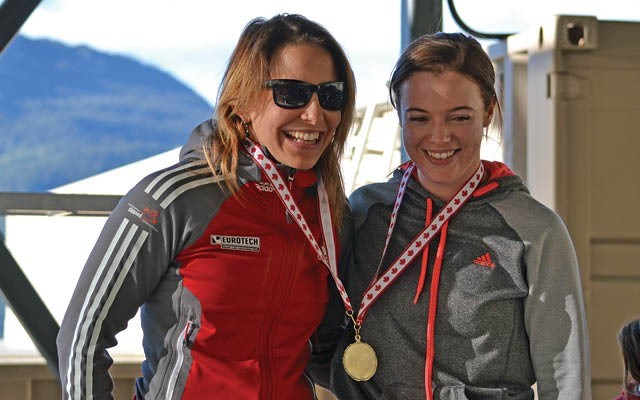There weren't enough gold medals to hand out at the Whistler Sliding Centre when it hosted the Canadian Skeleton Championships.
That's because Cassie Hawrysh and Robynne Thompson finished with identical two-run times of one minute, 49.62 seconds on Sunday, Oct. 27 to be declared co-winners of the women's national title.
Meanwhile, Dave Greszczyszyn slid his way to the men's title, coming from behind on the second run to become the Canadian champ in 1:47.24.
Thompson was also celebrating her 22nd birthday on Sunday. The crowd gathered at the finish dock for the awards presentation sang "Happy Birthday," as she and Hawrysh donned a gold medal that was quickly modified so that both could have it around their necks.
"It feels awesome. It's a pretty good birthday present," said Thompson. "I don't mind sharing it with Cassie."
Thompson led Hawrysh by 0.16 seconds after the first run, but Hawrysh had the quickest women's run of the day to help move her up into the tie for first.
"After that first run I joked with her and said, 'That was your birthday present, but you only get one run,'" laughed Hawrysh, 29. "This is a sport where that rarely happens and she's been working really hard ... so I'm super proud of her and obviously I'm super excited for myself."
Jaclyn LaBerge finished third, 0.47 seconds behind, while Lanette Prediger placed fourth and Mellisa Hollingsworth finished fifth. World Cup team veteran Sarah Reid did not participate in Sunday's race.
Similar to the women's race, Greszczyszyn trailed first-run leader John Fairbairn by less than two-tenths after one run, but had the fastest men's time of the day in the final heat to clock in with a combined time of 1:47:24. Fairbairn slipped to second spot and Eric Neilson finished in third place.
"It hasn't sunk in yet," Greszczyszyn said of being the national champ.
"(Fairbairn) was pushing lights out, so I knew I needed a good run. Run 1 was pretty good — I had a couple of spots to clean up, but I cleaned those up for Run 2, just let 'er go, hoped for the best and it was the good run that I needed there."
Patrick Rooney finished fourth on Sunday while 2010 Olympic champ Jon Montgomery placed fifth.
In a scary moment, national development team athlete Barrett Martineau was stretchered off course after popping out of the start groove and hitting his head early in his first run Sunday. He was taken for treatment as a precaution but Bobsleigh Canada Skeleton officials said Martineau would be fine.
Sunday's competition was the second of two selection races for the national team. Olympic medallists Montgomery and Hollingsworth were both left off the World Cup roster to start the year and will begin their winters at the Intercontinental Cup level. The men's World Cup squad will feature Sunday's podium finishers, while the women's will include Reid, Hawrysh and Thompson.
Less is more for skeleton squad
Canadian team head coach Duff Gibson said it was nice to have the Whistler Sliding Centre dedicated to the skeleton squad during its annual preseason visit, since the luge and bobsleigh crews had finished their training in the resort the week prior. But it wasn't as though the team was using every second of available ice during its stay.
Concussion problems have led to the early retirements of promising Canadian skeleton racers in recent seasons, and with that in mind, Gibson has been limiting his athletes to a maximum of three runs per day.
"In our sport, we're sort of paralleling what's going on in hockey and in football and a lot of other sports where they're slowly realizing the danger of head trauma," said Gibson, the 2006 men's Olympic champ. "In skeleton, we've kind of learned the hard way in that we've had athletes who didn't even hit their head, it was just the vibration (of sliding).
"We've really paid the price and lost some really good sliders ... and we figured we needed to take some steps to make sure that doesn't happen again."
Gibson said the move has been beneficial, as the time athletes spend off the track can still be used effectively by paying close attention to the finer details of each run, similar to the approach usually taken in bobsleigh training.
"I'm hoping it translates into a greater overall awareness of what is going on in a corner and, if anything, will aid in the development of a slider," said Gibson.
The team will now head to Russia to train on the 2014 Olympic track before returning to North America for the first three events on the World Cup calendar.




